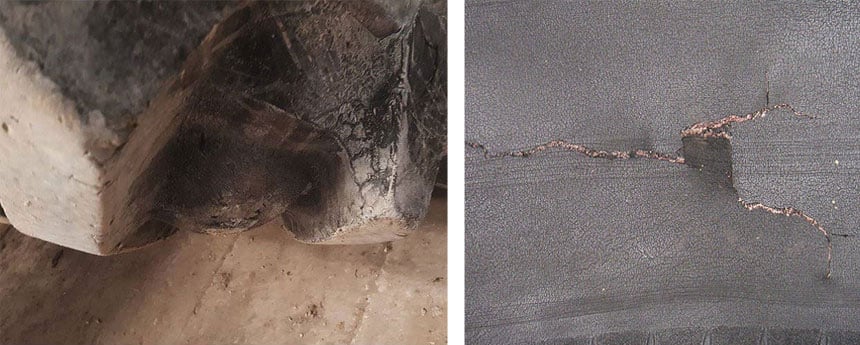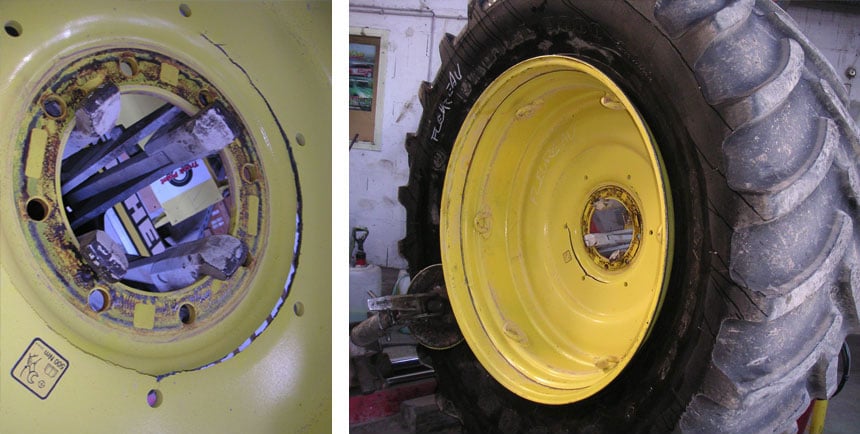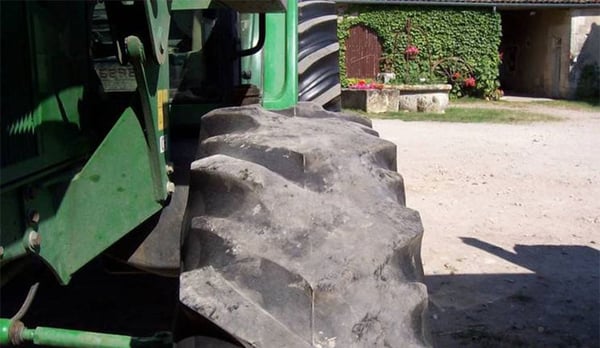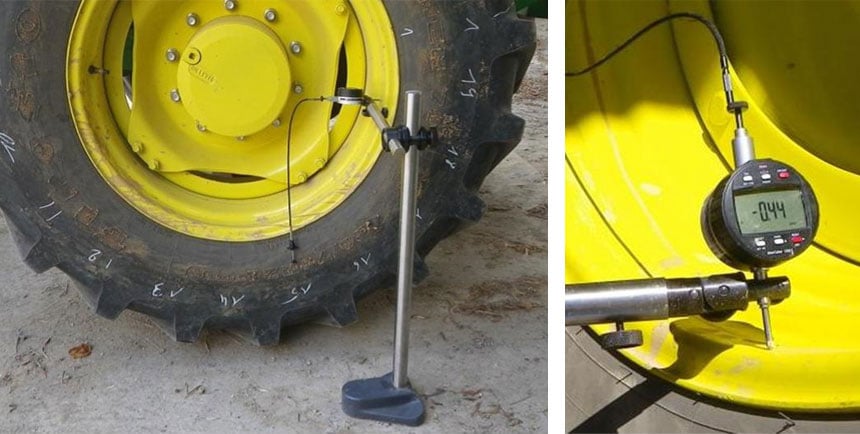Your agricultural tyres are wearing parts which are placed under very heavy strain; they do not require particular maintenance, but a regular check-up and a good measure of vigilance can help you make them last much longer. It may not seem worthwhile, but if you get into the habit of doing a ten-minute check-up regularly, you will be able to detect any problems well before any damage occurs and take remedial action to make sure that you can always work in the best conditions.
After regular cleaning, here is a 10-point check-up that you can follow before each campaign, or once a month if you use your tractor intensively, to earn several months’ peace of mind.
Static visual check-up points
To avoid bad surprises during your agricultural campaigns which could immobilise your tractor, it is highly advisable to carry out a visual inspection of certain parts of your tyres to detect any irregularities or warning signs of wear.
1. Is there any mark or anomaly on the tyre?
A rapid visual inspection of the sidewalls and tread will reveal any cuts, hernia or traces of a impact on the tyre.
Hernia on the sidewall or tread:
This is an abnormal bump which forms generally on the sidewall of the tyre. It may be caused by a lateral impact, a root, stone or branch.
A hernia cannot be repaired, so you may as well replace the tyre to avoid any risk of accidents or immobilisation with work in progress.
 A hernia often corresponds to a break in the inner lining of the tyre (photo on the right)
A hernia often corresponds to a break in the inner lining of the tyre (photo on the right)
Cuts on the sidewalls or tread:
Generally, slight cuts on the lug base or tip of the lugs which do not pose a problem. On the other hand, deeper cuts must not be neglected, wherever they are situated on the tyre.
If you come across a very deep cut, it's wiser to remove the tyre to check that the structure is not really damaged.
BEWARE: If a cut is due to a frontal impact, a jagged piece of metal or sharp object… it is possible that the casing has suffered more internal damage than is visible from the small external nick. An internal inspection will be essential in this case because the tyre could burst during pressure adjustments.
Breaks in the tyre’s butyl:
These appear in the form of regular creases on the sidewall and may be caused by frequent flexion and deflexion or linked to storage of deflated tyres during the winter, driving with a flat tyre or extended use of underinflated tyres.
This is a sign of fatigue, and your tyre should be replaced.
2. Is there any mark or anomaly on the rim?
The following check-up concerns the inspection of the rim. A rapid visual inspection around the rim area, above all at the level of the bead seat, makes it possible to check if it is clean or whether there are traces of an impact.
The bead area is a more fragile part of the tyre, and it is important to check that a knock has not damaged the bead or to avoid, as far as possible, accumulation of detritus or small stones which could lead to a loss of airtightness with the flexion and deflexion of the tyre.
 Break in the rim disc
Break in the rim disc
3. Is there corrosion at the level of the bolts?
The rims, which are generally made of steel, may be damaged during intensive use in difficult conditions.
The movement and flexion due to daily use, and impacts may provoke small fissures and corrosion on the sensitive parts of the wheels.
To avoid unpleasant surprises, it is important to check the presence or progression of corrosion on the rims and more specifically on the wheel bolts.
The problems which arise frequently concern the deformation of the bolt area, which is often due to automatic unscrewing, or incorrect tightening during repairs, leading to looseness and friction between the joint threads as well as corrosion.
This type of problem can lead to disassembly and cause heavy vibration when driving. To remedy the situation, just remove any rust and adapt the tightening of the bolts regularly.
4. Is the valve cap missing?
This detail is often neglected by many farmers because the cap seems to play only a superficial role. However, the valve is the weak point which permits the flow of air and, depending on how tight it is, it makes it possible to contain the pressure in the tyre. The cap is what protects this weak point.
Without a cap and following a badly placed impact to the valve core, even a slight knock, airtightness can diminish immediately, leading to loss of pressure and the risk of driving with underinflated tyres, which could destroy the tyre’s casing and cost far more than just a valve cap.
5. Presence of foreign bodies?
Your agricultural tyres face different strains on a daily basis. You must regularly check for foreign bodies on the sidewalls, tread or at the level of the bead, such as branches, earth, stones, etc. These may bring a risk of corrosion of the rim, ore more frequently a problem at the level of the bead.
When you carry out your inspection, make sure that the contact area between the edge of the rim and the tyre bead is not damaged. The presence of foreign bodies at this level can cause damage linked to the permanent flexion and deflexion of the tyre when you drive. In any case, you should make sure that your tyres are cleaned regularly and get rid of dirt after each use.
6. Irregular wear to the lugs?
When you discover irregular wear at the level of the lugs, in most cases this is a sign of incorrect parallelism.
Agricultural tyre wear may be of mechanical origin, which is to say that it is linked to incorrect adjustment of the axis of the two tractor wheels compared to the centreline of the tractor.
- If the front of the tyres point outwards from the centreline, there is too much toe-out, leading to premature wear to the inside of the tyres.
- Inversely, if the front of the tyres point slightly inwards, this is called toe-in, and the wear is concentrated more on the outside of the tyres.
Ideally your tyres should be perfectly parallel to your tractor to avoid irregular wear to the lugs.
 Wear linked to incorrect parallelism
Wear linked to incorrect parallelism
Checking parallelism is a simple and rapid operation. It allows you to establish the type of geometrical problem you have and to extend the useful life of your agricultural tyres by making a minor adjustment.
Irregular wear to the tread may also be due to wear to the axles, pins or bearings.
There may also be irregular wear to the rear axle, which is generally due to misalignment of the trailer axles during intensive use on the road.
7. Under or overinflated tyres?
Checking tyre pressure is vital and obligatory if you want your tyres to resist the load and allow you to work in the best possible conditions.
- If your tyres are regularly underinflated, and you travel frequently by road: you will increase fuel consumption and reduce the stability of your trailer when braking or cornering. Your tyre will tend to wear more rapidly, on average with a 25% shorter lifespan.
In addition, if pressure is really too low on the road, this will encourage overheating of the rubber components and metal elements of the tyre and may result in the tyre bursting.
- On the other hand, if inflation pressure is too high, this leads to other problems in the fields: such as an increase in rolling resistance, more slip which leads in turn to more than 20% more fuel consumption and systematic soil compaction on your land.
Check-up points when driving
Part of the check-up can be carried out when driving, just after the static check-up. When driving, you must pay close attention to abnormal vibrations, to road handling and to any lateral sway.
8. Abnormal vibrations when driving?
Because of the different types of strain placed on your wheels on a daily basis: ruts, heavy ground, rough terrain, etc...
It is relatively normal for there to be slight shifts in the settings and vibrations when driving are often the result of incorrect parallelism which will cause the rapid deterioration of your agricultural tyres:
- A 5 mm inaccuracy in settings may reduce your tyre’s lifespan by approximately 12%.
- A 15 mm error in parallelism (toe-in or toe-out) can cause a reduction in the tyre’s lifespan by up to 36%.
9. Problem with directional stability?
Just like abnormal vibrations when driving, a problem with directional stability is often caused by an error in parallelism.
The progressive geometrical imbalance at the level of your agricultural tyres depends on your use of the tractor. When you identify one of the following problems, this is certainly linked to parallelism:
- Your tractor pulls slightly to the left or right, in an unusual way.
- You feel more resistance when steering around a bend to the right than to the left, or the other way round.
10. Sway or abnormal bouncing
A left/right sway effect when driving may be linked to several causes, but the most frequent are as follows:
Mounting error:
The tyre may have been incorrectly installed on the rim seat, the bead is badly positioned which leads to this swinging movement only when driving at speed.
Rim error:
The rims may not be perfectly round and bigger than the reference size. A rim which is slightly oval can cause this abnormality when driving. It will be necessary to change the rim to avoid wearing the tyre too rapidly.
 Tool for measuring tyre concentricity
Tool for measuring tyre concentricity
Tyre fault:
There may also be a tyre manufacturing imbalance with a slightly oval shaped tyre. Your tyre dealer has equipment to check tyre concentricity (perfectly identical radius for all measurements from the centre).
To help you clearly define the causes of premature wear on your current tyres, we have developed a complete guide for you to download free of charge "How to detect abnormal wear in my tractor tyres"

Most people who read this article have also read some of the following articles:
This information is intended only to make you aware of the technical and functional aspects of agricultural tires and their use. It does not allow you to make a judgment or a definitive conclusion on a given problem. Only your agricultural tire expert is able to make a technical assessment and take a final decision, case by case.